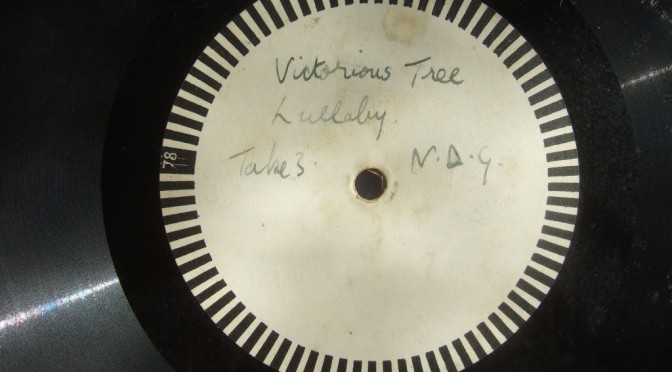I have acquired two discs which I think might be the oldest recordings of early Irish harp music, recorded in April 1937. I have not yet played them to hear what is on them – I am still trying to source a suitable stylus for my turntable.
They are one-off lacquer gramophone records, also known as transcription discs – the 1930s equivalent of a cassette tape, for direct recording as a one-off copy. These are not reproductions or duplicate pressings so are almost certainly the only copies that exist of these takes.
Here’s the handwritten label of one of the discs, a double-sided 10-inch disc:
Victorious Tree
Lullaby
Take 3. N.D.G
(The other side of this disc says “Tests – A.D. on outer ring – II.IV.37”)
And here is the second record, a 12 inch single-sided disc:
D II Take I
Irish Harp Music.
Mrs. Dolmetsch.
The Victorious Tree.
Lullaby.
These records came from a collection of Dolmetsch discs, tapes and papers. Some of the other discs indicated that they were recorded by L. Ward.
Arnold Dolmetsch made a number of harps, both small gut strung instruments as well as the early Irish harps modelled on the
Queen Mary harp and
Trinity College harp, and fitted with metal wire strings. Mabel used them mainly for exploring the medieval Welsh repertory preserved in the Robert ap Huw manuscript, and in 1937 they released a set of gramophone records with an accompanying book of sheet music “translated” from the manuscript. Mabel played this Welsh music on the wire-strung Irish harp, and her performances and Arnold’s editions proved very influential; Alan Stivell included performances of these versions on his LP “Renaissance of the Celtic Harp”.
However I did not know until now that Mabel had also experimented with Irish repertory. “An Bile Buadhach” (The Victorious Great Tree) comes from Edward Bunting’s 1809 collection; it was collected by Bunting from an unnamed informant “at Lord Clanbrassil’s” house, Tollymore Park, co. Down, “in 1793”.
When I get the correct stylus for my turntable I will play these discs once, digitise them and present them here for you! I am not going to put them on the gramophone machine – I understand that these transcription discs are extremely fragile and wear out very quickly from only a few plays.
Here’s what Mabel had to say about her own playing of the early Irish harp music:
…the small, metal-strung variety [of harp], favoured in Ireland, and the Highlands of Scotland, under the name of Clarsach. I never ceased to thank him [Arnold Dolmetsch] for producing these most fascinating of instruments, whose suavely tuneful music rejoices the heart and charms the senses. One day when I was recreating myself with one of these little instruments, a neighbour who had asked if she might use our telephone, came running into the music room, exclaiming: ‘Oh, what are those lovely sounds? That is the kind of music I want to hear when I am dying!’
From Mabel Dolmetsch, Personal Recollections of Arnold Dolmetsch, RKP, 1957, p148




What about using a non-destructive playback system like lasers or whatever first? I understand the desire to use an original playback method and then recording it though.
You might like this wooden record:
http://vimeo.com/65533918
Peter Wilson
Thanks Peter! I don't have a laser turntable! The original playback would be on an old wind up gramophone with a heavy steel needle but that would chew the record up in short order! I'll use a modern turntable with a modern stylus, should not cause too much destruction if I set it all up right!
I know that some old gramophones used hawthorn needles and came with a block of fine sandpaper to sharpen them. Maybe that would be less destructive than a steel needle, but then maybe more destructive than a more modern stylus? Have you put a call out for an optical playback system? I know that some universities have them and you never know who might have an old laser turntable. Good luck!
Peter